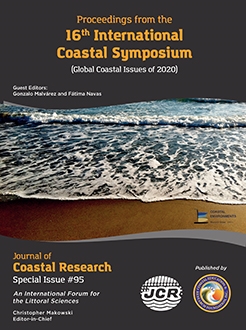Dillenburg, S.R.; Barboza, E.G.; Rosa, M.L.C.C.; Caron, F., and Bitencourt, V.B., 2020. Changes in the littoral drift of the Uruguayan coast during the Holocene and its influence in the continuing erosion in southern Brazil. In: Malvárez, G. and Navas, F. (eds.), Global Coastal Issues of 2020. Journal of Coastal Research, Special Issue No. 95, pp. 453–457. Coconut Creek (Florida), ISSN 0749-0208.
In northern Uruguay and southern Brazil, a littoral drift system dominates from southwest to northeast. This littoral drift is a consequence of higher wave-energy, generated in southern latitudes and that has been operating on a long-term scale, playing an important role not only in the evolution of coastal barriers of this region during the Holocene but also in coastal erosion that presently occurs in some parts of this coast. From La Coronilla to Cabo Santa Marta, which is a coastal sector 750 km - along the coast is gently undulating, showing gentle projections located to the south of gentle reentrances, that are dominated by transgressive/stationary and regressive barriers, respectively. In general, the regressive barriers have been developed by sediments brought into the reentrances by long-shore currents. The main source of these sediments had been the transgressive/stationary barriers that occur along the coastal projections. This differentiation of barrier behavior started at around 6-5 ka, at the end of the Postglacial Marine Transgression (PMT), when all rivers were drowned, finishing the delivery of new coarse sediments to the coast. Also, at this time the large rock promontories of the Uruguayan coast were formed and started to retain sediments of the littoral drift system, triggering a long-term coastal erosion in the southernmost coastal projection. Regarding erosion that is occurring in this stretch of coast the important issue to be considered in future coastal planning is that erosion will continue to operate in the long-term but will also be (and certainly has been already) amplified by sea-level rise in the next centuries as projected by the Intergovernmental Panel on Climate Change (IPCC).





